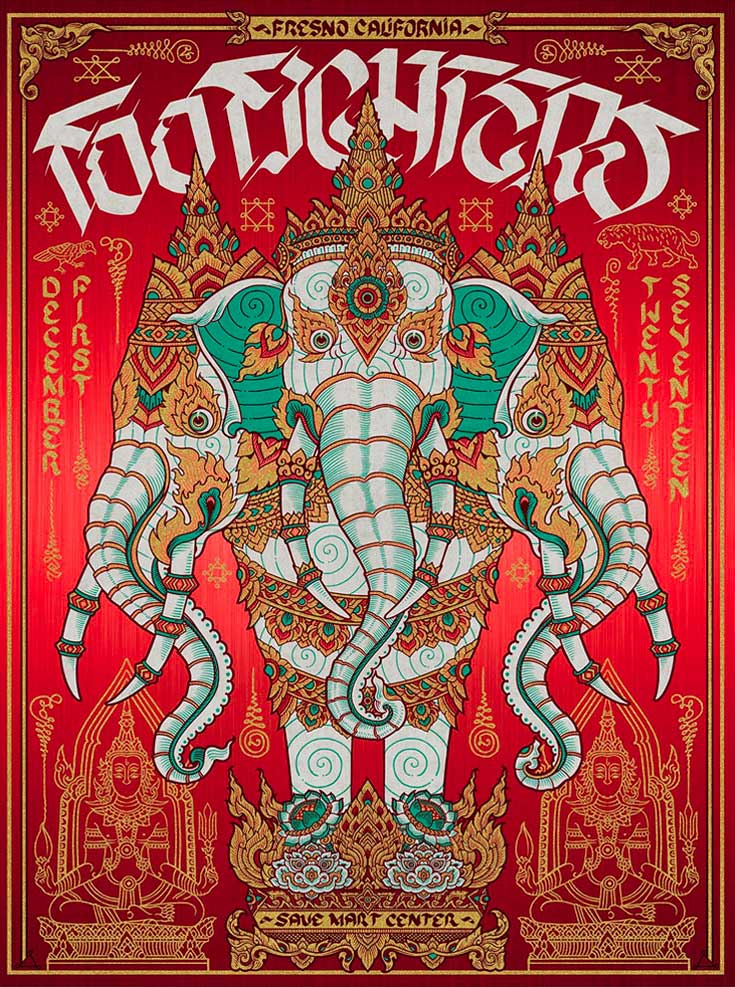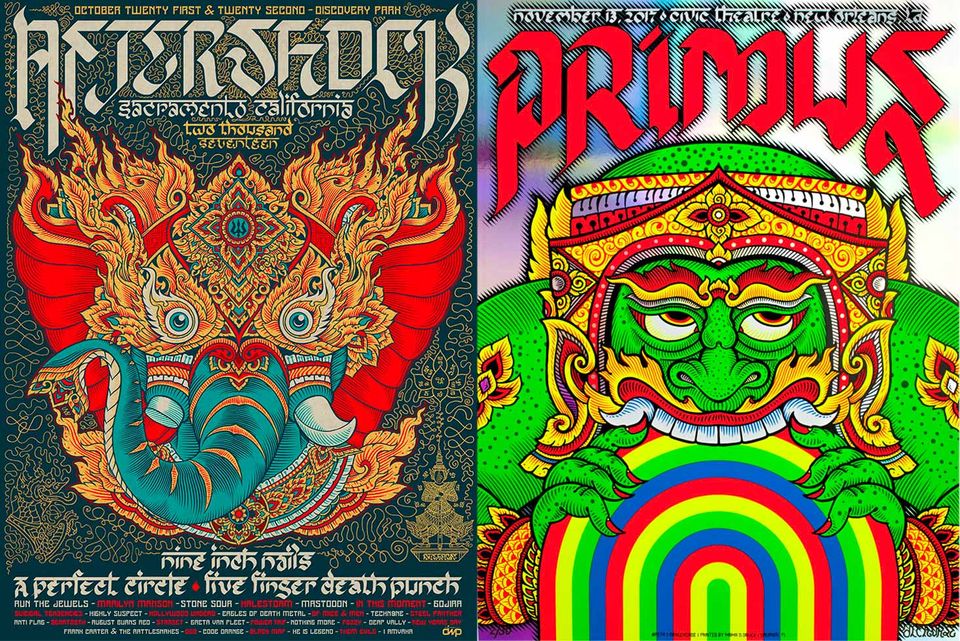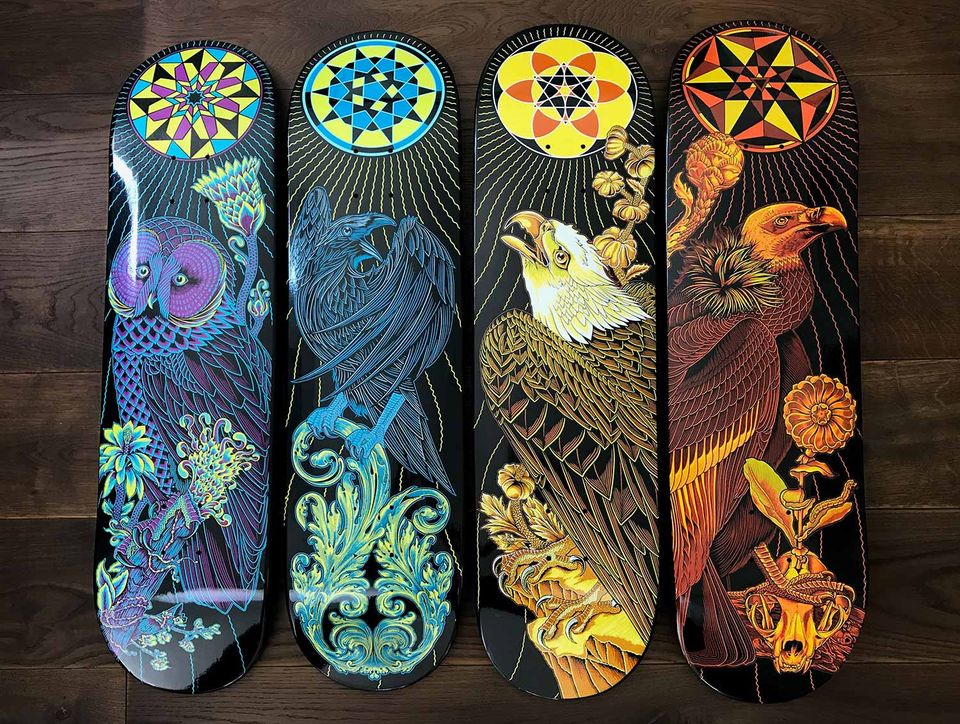Artist Spotlight: Chris Parks
Website Editor • June 17, 2019
Everyone’s work is deeply idiosyncratic: in our regular Spotlight segment we explore artists’ experiences and inspiration to understand what defines and inspires their unique styles.
Can you give us a brief background on yourself?
To start at the beginning, I was blessed with being born with a rare joint condition called congenital hip dysplasia that had me in and out of hospitals and surgical procedures throughout my early years, leading up to a total hip replacement procedure a few years back. Without this challenge, I would have likely followed the path of those before me, winding up in some sort of manual labor or construction job after school. Because of this, I remember always thinking about alternative ways to survive that didn’t involve strenuous, physical work. This lead me to discovering the realm of graphic design way back in a time when neither I, nor my friends, even had computers in our homes. I saw this as my best shot at a career where I could earn a living while sitting at a desk and not want to kill myself from the boredom of a desk job. I plunged into the Adobe software, learning it in and out during high school and eventually enrolling at the Ringling College of Art to earn my degree. After graduation I was hired at a product design agency where I learned the ropes professionally, while creating artwork for bands, surf/skate companies, and street wear brands during my nights and weekends.
What kind of influence does your location have on your career?
My studio has made it’s home in downtown St. Petersburg, Florida going on twelve years now. While I’ve always earned much of my income working with clients and commissions outside of my hometown, this area has always had a uniquely bohemian, creative, and bubbling art and music scene that has certainly influenced my career. Over time, I found myself making the transition from graphic designer into professional illustrator. After being invited to create work for various pop-up group exhibitions, where I challenged myself to find interesting ways to transform my digital creations into large format gallery works, using whatever production technologies I could get my hands on at the moment. I also started hosting gallery exhibitions at my first studio space that I shared with my business partner at the time, who was a tattoo artist. This was a highly inspirational time in my career where I absorbed a lot of influence from all of the gallery work and tattooing going on around me and applying it to my digital illustration process. I’ve also had the opportunity to curate and host 3 international mural festivals here in St. Petersburg. During these festivals, we’ve worked with the best local talent and flown in top traveling artists from around the globe to paint more than 50 murals right here in the heart of downtown since 2015. This project has put our city on the map as a renown destination for art and culture and has me moving into the next phase of my career as a mural artist.
What is your greatest source of inspiration?
Inspiration has always come to me most intensely when traveling. There is something magical that happens when I find myself in a strange new environment where everything feels fresh, electric, and full of novelty. I also have a daily meditation practice where I purposefully train my mind to receive creative insights from the unseen forces that are constantly flowing through everything in the universe. It removes lot of pressure when I can trust the inspiration to visit me when I need it.
Could you pick one piece of art that has made a lasting influence on you, and if so why?
Over 15 years ago I took my first trip to Bangkok, Thailand where I visited its sacred temples with guardian Yaksha demons standing at the entrances, enormous Buddha statues, and insanely detailed mural paintings found within. The murals depicted scenes from the original Hindu epic, known in Thailand as the Ramakien, where Hanuman and his army of courageous monkeys battle against the forces of evil lead by the demon king, Ravana. The beauty and power that emanated from these temples has never left me and has lead me to an ever-growing interest to practice and explore the deeper truths contained within the beauty of the artwork and it’s esoteric mythology. The artistic depictions of gods and demons that I absorbed during those trips so long ago are now the main drive for my current creative explorations.
What skills or techniques do you find most useful in your line of work? Do you use primarily traditional or digital methods to create your artwork?
I primarily work digitally, creating my illustrations with a 24HD Wacom Cintiq tablet in Adobe Photoshop. I also create typography and graphic work in Adobe Illustrator and I use my iPad Pro for concept sketching. My work is often produced as screen-printed posters, skateboards, laser engravings, T-shirts, artist products, packaging, and digital output for web and animation. I utilize a range of techniques for each. I’ve also begun to dabble in painting wall murals and experimenting with hand-drawn calligraphy lettering.
How can people who are interested in discovering more of your work find it?
I post daily updates to my Instagram account: https://www.instagram.com/palehorsedesign/. My portfolio site and online store can be found at: http://palehorsedesign.com/. I also send out a monthly email packed with my favorite audiobooks, podcasts, and music that I am constantly digging up to listen to while I draw, https://tinyurl.com/y8egd9xr.
Scriba is a revolutionary digital stylus that is ergonomically designed to comfortably fit your hand and uses unique Squeeze-Motion technology. Order here.
Articles

In the period since COVID forced many of us back home and out of the office, remote work has become the new norm for many. The flexibility of working from home, especially for those with small children, is very compelling, but making a productive workspace is more than setting up a desk in the spare room. More people are seeking to create functional and comfortable workspaces in their homes, however, it can be difficult to strike the right balance between a professional office space and a cosy home environment. Here are some tips for designing a home workspace that meets both of these needs: Dedicate a specific area for work Designating a specific area for work is essential for separating work from leisure time. This could be a separate room or just a corner of a room. It is important to make sure that the workspace is free from distractions and clutter, as this will help you stay focused and productive. Choose the right furniture Ergonomic furniture is key to a comfortable and productive workspace. Invest in a comfortable chair, a desk that is the right height, and a good-quality mouse and keyboard. If you are prone to back pain, consider a standing desk. Add personal touches Just because your workspace should be functional, doesn’t mean it can’t be personal. Add photos, plants, and other personal items to make the space feel like your own. This will help create a sense of comfort and make you feel at home in your workspace. Good lighting Good lighting is essential for a comfortable workspace. If possible, place your desk near a window for natural light. If not, invest in a high-quality desk lamp to provide bright, even light. Keep it organised An organised workspace will help you stay productive and focused. Use desk organisers, filing cabinets, and other tools to keep your work area free from clutter. A clean and organised workspace will also help you start each day with a clear mind. Consider your work style Think about the type of work you do and how you like to work. If you prefer a minimalist workspace, opt for a simple desk and a few basic supplies. If you need space for multiple screens and other technology, make sure you have enough room to work comfortably. Take breaks It’s important to take breaks throughout the day to avoid burnout. Step away from your desk, go for a walk, or do some stretching exercises to clear your mind and recharge.













